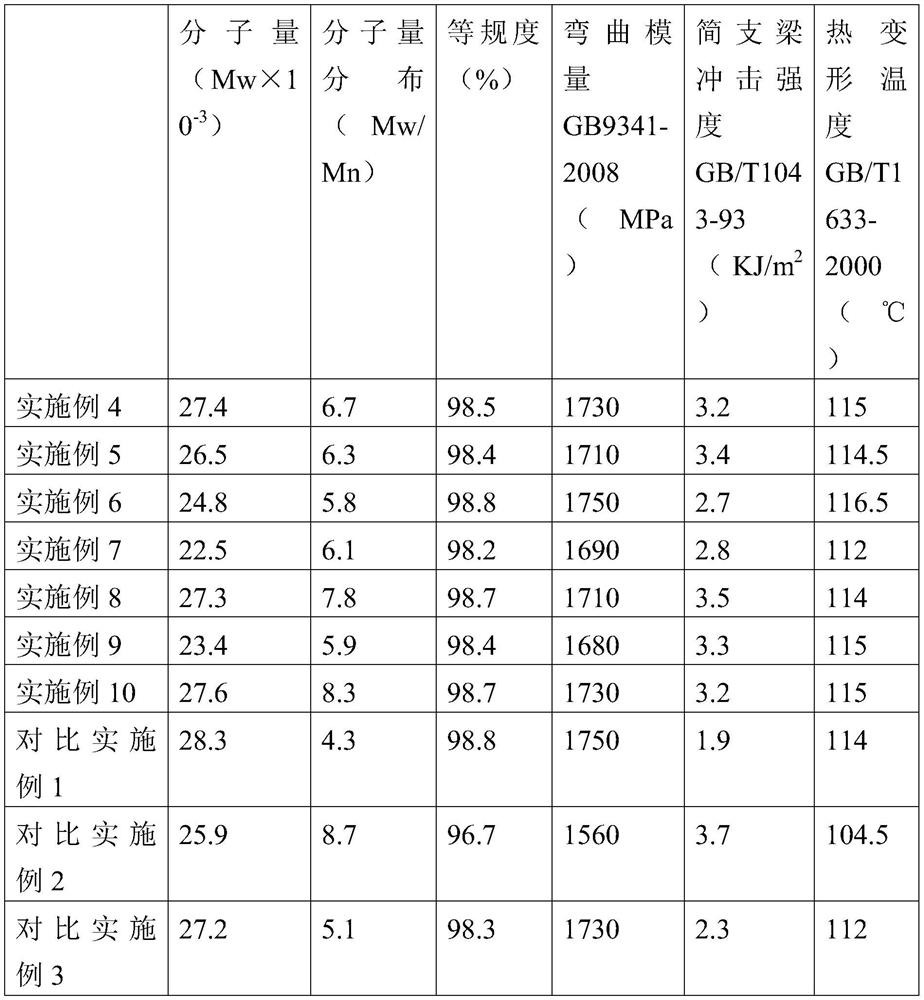A kind of propylene polymerization catalyst system and its application
A technology of propylene polymerization and catalyst, which is applied in the application field of preparing high-rigidity heat-resistant polypropylene, and can solve the problems of low-standard polypropylene
- Summary
- Abstract
- Description
- Claims
- Application Information
AI Technical Summary
Problems solved by technology
Method used
Image
Examples
Embodiment 1
[0026] The solid component (A) is the preparation of the main catalyst:
[0027] Under nitrogen protection, in a 500ml four-hole glass reactor, at 0 ℃, first add 250ml of titanium tetrachloride, and under stirring, add 10g of magnesium chloride alcoholate (MgCl 2 *2.8C 2 H 5 OH) was added dropwise to the cooled titanium tetrachloride, and after the dropwise addition was completed, the temperature was raised to 120° C. for a predetermined time of reaction, allowed to stand, and filtered with suction. After dropping to room temperature, add 250 ml of titanium tetrachloride, then heat up to 100 ° C and add 2.05 g (about 7.4 mmol) of diisobutyl phthalate (DIBP) internal electron donor, and react at this temperature for 1 h, The temperature was raised to 120° C. to react for a period of time, left standing, washed several times with toluene and n-hexane, and vacuum-dried to obtain free-flowing catalyst particles cat-1. Solid catalyst component titanium content: 3.2%, ester conte...
Embodiment 2
[0029] The solid component (A) is the preparation of the main catalyst:
[0030] Under nitrogen protection, in a 500ml four-hole glass reactor, at 0 ℃, first add 250ml of titanium tetrachloride, and under stirring, add 10g of magnesium chloride alcoholate carrier (MgCl 2 *2.8C 2 H 5 OH) was added dropwise to the cooled titanium tetrachloride, and after the dropwise addition was completed, the temperature was raised to 120° C. for a predetermined time of reaction, allowed to stand, and filtered with suction. After cooling to room temperature, add 250ml of titanium tetrachloride, then heat up to 100°C and add 2.10g of di-n-butyl phthalate (DNBP) as an electron donor, react at this temperature for 1h, then heat up to 120°C for a period of reaction time, left to stand, washed several times with toluene and n-hexane, and dried under vacuum to obtain free-flowing catalyst particles cat-2. Solid catalyst component titanium content: 2.8%, ester content 11.7%.
Embodiment 3
[0032] Preparation of di-n-butyl 2-cyano-2,3-dimethylsuccinate:
[0033] using S N 2 is prepared by coupling, and the preparation method can refer to the method used in CN1240729C.
[0034] At 0°C, 157 mmol of 2-cyanopropionic acid was added to a freshly prepared solution of lithium diisopropylamide (41 mL, 314 mmol of diisopropylamine and 126 mL of BuLi (2.5 M in hexane; 314 mmol) and 1 L of tetrahydrofuran THF). The mixture was stirred at 0°C for 15 minutes and then at 45°C for 4 hours while in a separate reactor 14.1 ml (157 mmol) 2-bromopropionic acid and 28 g (157 mmol) hexamethylphosphoryl were added at 0°C The mixture of triamine HMPA was added to a suspension of 3.8 g (157 mmol) NaH in 500 mL THF while controlling gas formation. After the addition, the mixture was stirred at 0°C for 15 minutes, then the mixture was added to the above mixture of lithium 2-cyanopropionate at 0°C, and the mixture was stirred at 35°C for 2 hours at 0°C. The mixture was rapidly cooled w...
PUM
| Property | Measurement | Unit |
|---|---|---|
| heat deflection temperature | aaaaa | aaaaa |
| flexural modulus | aaaaa | aaaaa |
| impact strength | aaaaa | aaaaa |
Abstract
Description
Claims
Application Information
 Login to View More
Login to View More - R&D
- Intellectual Property
- Life Sciences
- Materials
- Tech Scout
- Unparalleled Data Quality
- Higher Quality Content
- 60% Fewer Hallucinations
Browse by: Latest US Patents, China's latest patents, Technical Efficacy Thesaurus, Application Domain, Technology Topic, Popular Technical Reports.
© 2025 PatSnap. All rights reserved.Legal|Privacy policy|Modern Slavery Act Transparency Statement|Sitemap|About US| Contact US: help@patsnap.com

